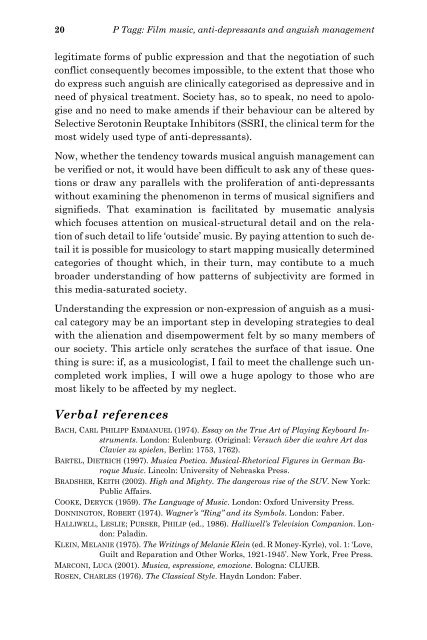Film music, antidepressants and anguish management - Philip Tagg
Film music, antidepressants and anguish management - Philip Tagg
Film music, antidepressants and anguish management - Philip Tagg
You also want an ePaper? Increase the reach of your titles
YUMPU automatically turns print PDFs into web optimized ePapers that Google loves.
20 P <strong>Tagg</strong>: <strong>Film</strong> <strong>music</strong>, anti-depressants <strong>and</strong> <strong>anguish</strong> <strong>management</strong><br />
legitimate forms of public expression <strong>and</strong> that the negotiation of such<br />
conflict consequently becomes impossible, to the extent that those who<br />
do express such <strong>anguish</strong> are clinically categorised as depressive <strong>and</strong> in<br />
need of physical treatment. Society has, so to speak, no need to apologise<br />
<strong>and</strong> no need to make amends if their behaviour can be altered by<br />
Selective Serotonin Reuptake Inhibitors (SSRI, the clinical term for the<br />
most widely used type of anti-depressants).<br />
Now, whether the tendency towards <strong>music</strong>al <strong>anguish</strong> <strong>management</strong> can<br />
be verified or not, it would have been difficult to ask any of these questions<br />
or draw any parallels with the proliferation of anti-depressants<br />
without examining the phenomenon in terms of <strong>music</strong>al signifiers <strong>and</strong><br />
signifieds. That examination is facilitated by musematic analysis<br />
which focuses attention on <strong>music</strong>al-structural detail <strong>and</strong> on the relation<br />
of such detail to life ‘outside’ <strong>music</strong>. By paying attention to such detail<br />
it is possible for <strong>music</strong>ology to start mapping <strong>music</strong>ally determined<br />
categories of thought which, in their turn, may contibute to a much<br />
broader underst<strong>and</strong>ing of how patterns of subjectivity are formed in<br />
this media-saturated society.<br />
Underst<strong>and</strong>ing the expression or non-expression of <strong>anguish</strong> as a <strong>music</strong>al<br />
category may be an important step in developing strategies to deal<br />
with the alienation <strong>and</strong> disempowerment felt by so many members of<br />
our society. This article only scratches the surface of that issue. One<br />
thing is sure: if, as a <strong>music</strong>ologist, I fail to meet the challenge such uncompleted<br />
work implies, I will owe a huge apology to those who are<br />
most likely to be affected by my neglect.<br />
Verbal references<br />
BACH, CARL PHILIPP EMMANUEL (1974). Essay on the True Art of Playing Keyboard Instruments.<br />
London: Eulenburg. (Original: Versuch über die wahre Art das<br />
Clavier zu spielen, Berlin: 1753, 1762).<br />
BARTEL, DIETRICH (1997). Musica Poetica. Musical-Rhetorical Figures in German Baroque<br />
Music. Lincoln: University of Nebraska Press.<br />
BRADSHER, KEITH (2002). High <strong>and</strong> Mighty. The dangerous rise of the SUV. New York:<br />
Public Affairs.<br />
COOKE, DERYCK (1959). The Language of Music. London: Oxford University Press.<br />
DONNINGTON, ROBERT (1974). Wagner’s “Ring” <strong>and</strong> its Symbols. London: Faber.<br />
HALLIWELL, LESLIE; PURSER, PHILIP (ed., 1986). Halliwell’s Television Companion. London:<br />
Paladin.<br />
KLEIN, MELANIE (1975). The Writings of Melanie Klein (ed. R Money-Kyrle), vol. 1: ‘Love,<br />
Guilt <strong>and</strong> Reparation <strong>and</strong> Other Works, 1921-1945’. New York, Free Press.<br />
MARCONI, LUCA (2001). Musica, espressione, emozione. Bologna: CLUEB.<br />
ROSEN, CHARLES (1976). The Classical Style. Haydn London: Faber.














